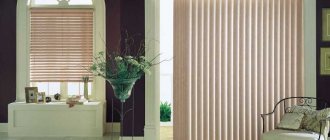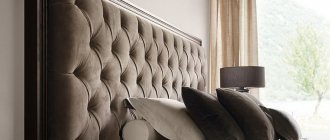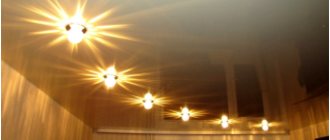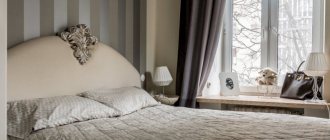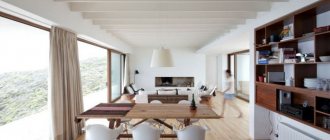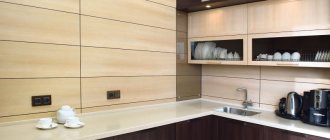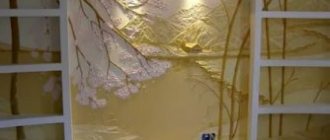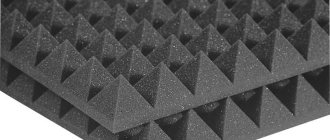What are moldings and what are they like?
Molding is a decorative strip of convex or concave shape. It is used for decoration, harmonization of interiors, visual correction of room defects. Moldings can be narrow - a couple of centimeters wide, and wide - up to 20 cm. They are used for interior and exterior decoration, and can be rigid or flexible. They come with a longitudinal relief (most often), with floral or geometric patterns.
Depending on the installation location, moldings can be ceiling, wall, or corner. Corner ones are usually placed at the junction of the wall and ceiling. Moldings are made from:
- Foam plastic. The cheapest. They have a slightly loose surface, so they are only suitable for puttying and painting. Attached to a flat wall using glue.
Moldings in the living room interior are a very common type of decor. - Polyurethane. More expensive, dense, with a smooth surface. They also stick to walls and ceilings.
- Plastic. Smooth with a shiny surface. They wash well, have a long service life, but are not combined with all materials and are not suitable for all interiors.
- Plaster. Heavier ones are made by casting. Massive elements are attached with nails or self-tapping screws, thinner ones can be glued with a special adhesive composition.
- Wood. Wooden moldings are attached to finishing nails or regular nails without heads. Gluing with wood glue is possible. Fits well into classic, Scandinavian, Russian interiors. All those in which wood trim or decorative items are present in one form or another.
Only a small part of the options with patterns - Metal. They are very durable, but metal moldings can only be used in interiors of a certain type - minimalism, hi-tech, loft.
- Polymer flexible. Polymer flexible moldings are used to decorate columns and rounded walls. They are attached with glue.
Plaster moldings appeared in ancient times. They became the model by which decorative strips for interior decoration were created from more modern and cheaper materials - foam plastic and polyurethane.
Molding for stretch ceiling
One of the categories where the use of soft ceiling moldings and overlays is the only possible option is a suspended ceiling. The very structure and design of the PVC sheet implies the absence of rigid fastening of the upper edge of the cornice strip to the ceiling surface. Therefore, the molding has to be mounted on an aluminum frame profile. The result is a thin and narrow, barely noticeable line covering the seams and frame elements.
The decor with a cantilever fastening of the overlay strip looks much more interesting. In this case, the molding is glued to the wall only in the lower part, and the horizontal shelf touches the ceiling surface of the PVC film. In this way, decorative ceiling borders of unlimited sizes and shapes can be mounted on suspended ceilings.
Ceiling molding with LED strip
Where can they be used?
Moldings in the interior are used in the following cases:
- To harmonize the interior. Smooth empty walls and flow are not always attractive. The use of moldings allows you to make the interior more harmonious.
- To separate colors, materials, textures on walls.
In classic interiors, molding is a tradition - For masking cables, communication lines, etc.
- For decorating joints of slabs and wallpaper.
- Zoning of premises.
- Design of doorways.
- Decoration of paintings, mirrors, wall-mounted TVs, etc.
The main function that moldings perform in the interior is decoration and decoration. At the junction of materials with different thicknesses, textures, and colors, this method of decoration allows you to turn an unaesthetic transition into a decorative element. The method is easy to install, most of it has a low cost.
How to make a panel with your own hands at home
The creation process is not that complicated. First you need to make a beautiful frame, inside which a composition of wallpaper will be created. The frame can be made of wood or polyurethane foam, twisted rope (especially such frames are suitable for a “marine” style) and much more. For the main idea, you can take a photo of a wallpaper panel on the wall. They will look beautiful as a frame.
Initially, you need to mark the future panel on the wall, carefully drawing the boundaries of the existing or future frame on both sides. Prepare the frame elements (process and apply glue) and glue them to the wall, you also need to cover the seams of the joints. The frame can be painted in a beautiful color that matches the style of the panel.
After decorating the frame, prepare the panel elements by first assembling the pattern on the floor (on the backing). Carefully coat each element with glue and carefully stick it on the wall. After completing all the work, trim off the excess edges around the perimeter of the entire panel.
Another option for beautiful wall decor is a wallpaper panel. Against the background of plain wallpaper, a bright, mirrored panel is created that will look very impressive on the wall of the room. But it should be the only bright element of the entire room, otherwise you will end up with an excessive amount of unnecessary details.
You can create a panel in the same way from leftover materials - decorating the room with pieces of various wallpapers. But this work requires great care and design taste, and you can start it only when you have a sketch of the future panel at hand.
Creating a bright and unique interior is in your hands. A little imagination and desire and everything will work out.
Each of us wants to make our home beautiful
and unlike any other.
There are many design
ideas and solutions for this.
One of the techniques in creating a stylish
The interior design of the apartment is the use of
moldings - overhead
decorative elements.
With the help of decorative moldings you can solve a variety of design
tasks.
The usual wallpapered walls
take on a completely different look, complete and complete.
At the intersection of different materials
If tiles or wall panels are laid only on part of the wall, the transition from tiles/plastic to a flat wall does not look very presentable. In order to make this transition more attractive, they use special border tiles, but they are too expensive - much more expensive than regular ones. No less interestingly, you can design this joint using molding. The decorative strip is mounted so that it covers the joint.
If the tiles do not lie up to the ceiling, the transition can be made using molding
The width and thickness are selected for the specific interior and the thickness of the materials being joined. Since we are usually talking about a bathroom, toilet or kitchen, it is more advisable to use materials that are easy to clean and are not afraid of high humidity. The optimal choice for tile joints is polyurethane. It can then be painted the same color as the wall or tile.
The transition from one material to another is best accomplished using molding
If you are decorating the transition between plastic panels and a painted/bleached wall, you can use a plastic plinth. Wooden panels or MDF panels are best joined to walls using wooden moldings.
The same technique works very well when you have to combine two colors or two textures. Moldings are used to separate and harmonize joints. This can be an accent wall, which is very fashionable now.
You can separate material of a different color using moldings
But an accent wall doesn't have to be a different color or pattern from start to finish. It is for such a case - if a canvas or material of a different color occupies only part of the wall - that moldings come in handy. They give a finished look to this finishing element.
Variations on a theme
How to make and choose decorative panels and wallpaper for the wall? If the kitchen is being decorated, the dining area can be highlighted with a beautiful decorative insert of photo wallpaper on a culinary theme. A very good solution is to use wallpaper on a plain background. A color addition will allow you to focus attention on a specific area, distracting from the shortcomings of the interior.
How to make sure that a kitchen or living room decorated with panels does not look beautiful and stylish? An effective addition to any interior design option would be an insert of wallpaper with floral and urban themes. By using images of the night or the city in the light of the rays of the rising sun, you can significantly increase the area of the room. A room, even a small one, will be perceived as more voluminous and spacious.
Ceiling moldings
The ceiling is often decorated with moldings. A large empty square just begs to be decorated with something. Typically, corner molding is installed at the junction of the wall and ceiling. It can be thin and simple - with a simple relief, or it can be wide, patterned, like stucco. Moreover, this type of decoration is good not only for classic interiors. It fits into the loft and other modern trends, with the exception of minimalism, perhaps.
Modern style also goes well with moldings
In addition, several decorative fragments can be located on the ceiling. For example, several moldings of different widths, but with a similar decor and profile. They can be placed at a distance from each other. Often, decorative fragments in the form of curls, corners curved in the other direction, half-arcs and other similar decorations are used in the corners. They also put decorative ceiling rosettes under the central chandelier in classical interiors.
This type of ceiling moldings is suitable for almost any interior.
If desired, decorative strips can be highlighted in color
This option is good for classic interiors
A way to make a ceiling beautiful
Another of the variations
If stretch or suspended ceilings are made, the transition is also finished using moldings
Options for decorating the ceiling with moldings
Moldings in the interior: on the ceiling
One of the simplest options for decorating a wall/ceiling joint using corner molding made of polyurethane
Small decorative element in the corner
You can join several decorative strips or place them at a certain distance
The ceiling doesn't always have to be white
But not only in the corner or near it can ceiling moldings be mounted. With their help you can create a unique ornament on the ceiling. Geometrically correct figures are created using polyurethane or gypsum planks. Using flexible molding you can create smooth lines.
In a long and narrow room, this technique helps to visually make it wider
Classic design with geometric pattern
If you use flexible moldings, you can make circles, arcs, smooth lines
To highlight the central part of the ceiling
Again, flexible molding on the ceiling - smooth transitions from one diamond to another, create an interesting effect
Dividing the ceiling into squares with molding is a classic decoration technique
And no one said that decorative strips should match the ceiling...
There is another technique - a coffered ceiling. This technique is usually used if you need to hide beams or some kind of flaw in the ceiling. In this case, moldings are also often used for decoration.
A coffered ceiling can hide beams, pipes and other unsightly elements
Recently, in most cases, polyurethane moldings are used in the interior. They are durable, easy to install, and not too expensive. All this makes them very popular.
Design of ceilings with moldings: photo
In the simplest case, finishing the corners can be built on the basis of a classic smooth ceiling border with a linear edging. Moldings of this design go well with floor borders, white lining of doors and interior passages.
The simplest solution for tension decor
“Carved” decor for drywall
A good example of matching ceiling and floor finishes
Polyurethane moldings always surprise with their quality and exquisite surface pattern
Moldings on the walls
Wall moldings are not just strips. Frames are made from these elements, which can simply limit part of the space in which a mirror or picture will hang. This selection helps to more clearly organize the space and highlight the subject.
Pictures framed from moldings
Frames made from moldings can also be filled with other finishing material. Previously, tapestries, brocade and other expensive fabrics were inserted into such frames. Today, they are increasingly using a different type of decorative putty, wallpaper, or simply a different shade of paint.
Inside the molding frame is a different color
Another common technique is the design of doorways. In addition to the standard frame of the opening, there is also a frame above the door. This space usually remains empty and is not used in any way. To ensure that there is no imbalance during complex decoration, molding is also glued here.
Slats over the door
Using wall moldings, you can visually make the ceilings higher. To do this, strips are installed at a certain interval. You can use them not only to make frames. These are decorative strips and are not too difficult to create patterns with.
Molding patterns on walls
All these decoration techniques require a large space, otherwise the room turns out to be too “overloaded”. In small rooms, if they are used at all, it is usually only planks at the junction of the wall and ceiling, and maybe a couple of thin strips to separate different textures or colors. Most often you can see moldings in the interior of the living room - these rooms are usually the most spacious. Moldings look good in bedrooms, but not in small ones, but at least in medium ones.
Molding for LED strip
Often, linings on walls or ceiling surfaces are used to install a built-in lighting system. This solution turns out to be much more convenient and simpler, and most importantly, the molding is easier to assemble than the classic option with the construction of plasterboard niches.
In addition, space is saved, and the ceiling lighting system itself looks more aesthetically pleasing. The only difference in design is where to install the LED strip, on the ceiling or on the wall. Depending on this, the direction of the light flux and the perception of the entire finish changes.
Ceiling molding with lighting
Structurally, the system itself consists of a white molding - profile, based on polyurethane or polyvinyl chloride, and a thin self-adhesive strip of LEDs. In order to direct most of the light flux to the surface of the stretch ceiling, the upper edge of the molding is cut off by at least 3-4 mm.
After sticking and installing on the ceiling, almost the entire flow of light will be directed parallel to the ceiling surface. The result is the effect of a floating or hanging ceiling. For those who have no desire to experiment, you can buy ready-made molding - a profile for hidden lighting of the ceiling surface.
Illuminated wall molding
There are quite a large number of models of side linings that are installed just below the ceiling level. The total width of such an overlay is no more than 50 mm.
Two lighting options
The luminous flux can be directed both to the lower and upper parts, or to symmetrically illuminate the ceiling and wall.
Two-tier molding with ceiling lighting
Often, when decorating the edging of a tension panel, both types of lighting are used, arranging it in several levels. The first, or upper tier, as a rule, is attached directly to the ceiling surface. The second profile is designed in the form of a luminous edging 5-7 cm below the first.
Moldings in the interior: photos, ideas
When decorating rooms with moldings, it is necessary to take into account not only the geometry of the room, but also the design style of the furniture. Decorative strips should have common features with the design of other interior items. Then the design will be consistent and harmonious.
You can insert beautiful wallpaper into molding frames
Wall moldings can be painted to match the walls. In this case, the moldings are not too noticeable, but the interior looks more harmonious
With the right approach, and in a modern style, moldings, and even patterned elements, are not superfluous
If the ceiling were just white, there would be obvious disharmony - too overloaded walls, and an empty ceiling
In a long and narrow hallway, frames visually expand the space
So that the wall is not empty
It's hard to think of another way to decorate
Wall moldings in the form of frames
If you need non-standard decorations, use moldings
The style of moldings should be consistent with the style of furniture design
Doors and wall decorations in one format
Modern classic
Moldings in the living room interior
There doesn't always have to be a lot of them
For spacious and bright rooms
In bedrooms, you should be careful with moldings
Scope of application and purpose of the molding
Externally, decorative ceiling moldings made of polyurethane are similar to gypsum stucco, but their performance is much better than that of their gypsum counterpart. Ceilings decorated with moldings, photos of which can be seen below, are easy to maintain.
Today, the construction market offers a wide range of molding varieties that can satisfy even the most sophisticated consumers. The main criterion when choosing this decorative material is one simple rule - the molding should emphasize the general style of the room being renovated. In the case of a classic style, it is advisable to use moldings with simple elegant lines, and vice versa, if the interior contains ethnic notes, then it is better to use ornamental elements.
Modern molding can be used as various finishing elements in renovation:
- as a plinth;
- as platbands;
- as elements of furniture decor;
- in the design of wall and ceiling surfaces.
Like no other decorative material, molding is suitable for hiding the joints of the ceiling and wall surfaces, while giving the design of the room an original and finished look, emphasizing the overall style of the renovation.
Quite often, the use of moldings allows you to combine several different finishing materials in one interior. So, for example, when combining walls covered with wallpaper and a stretch ceiling or decorative plaster and tiles.
Choosing the color of the molding
As a rule, moldings painted in neutral colors that harmonize with the shade of the wallpaper are more often chosen. In this case, the illusion of unity of the wall space is created and, at the same time, the decorative strip copes well with its dividing function.
It is not forbidden to make the molding an accent detail of the interior
Contrasting colors for decorative strips should be used with caution. It is not recommended to use contrasting horizontal moldings in rooms with low ceilings, as they will visually make the room even lower
You should also avoid using them in cramped spaces so as not to overload the space of a small room with unnecessary details.
Light moldings on a dark wall will make the interior lighter and more comfortable. In this case, when choosing one tone for the design of the ceiling line, baseboard and molding, it is easy to emphasize the originality of the wall decor.
How is molding different from cornice?
Molding
- an element of interior decor that has a straight back side and is designed to be attached to one plane. They are used to frame mirrors, windows, doors, highlight arches, panels on walls, etc. Moldings are used at the junctions of different finishing materials, for example, when the lower part of the walls has one finish, and the upper part another. Moldings can create luxurious accents by zoning or highlighting decorative elements. On the outside, they can have a variety of ornaments, patterns, or be made in a restrained, simple style.
Cornice
on the back side it has two planes and is designed for mounting in a corner, between the wall and the ceiling. The design of cornices can also be very diverse.
MDF and wood moldings
How to repair a hole in a suspended ceiling
If you want to use moldings in a modern interior, then you must understand that this detail should not be conspicuous, because its task is to serve as an addition and decoration.
In this case, special attention should be paid to the choice of material from which the moldings are made, because if natural materials predominate in your interior, plastic or foam plastic will not be the best solution. The problem with foam moldings is that they are very easy to damage, even with little pressure.
The problem with foam moldings is that they are very easy to damage, even with very little pressure.
A more serious impact will also leave damage that will be immediately noticeable, which is extremely undesirable.
A reliable option can be wood, the moldings from which are very durable, and also beautiful.
Durable rocks can easily withstand accidental impacts or contact with hard objects.
Taking into account the fact that now more and more people like to use backlights almost everywhere, molding manufacturers decided not to stay away from the new wave and began adding backlit moldings to their product lines.
